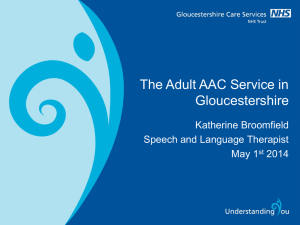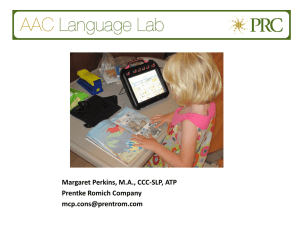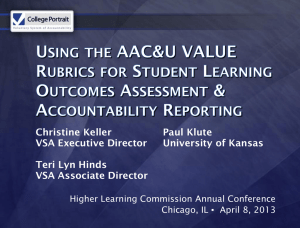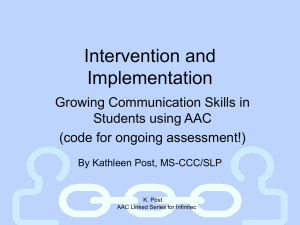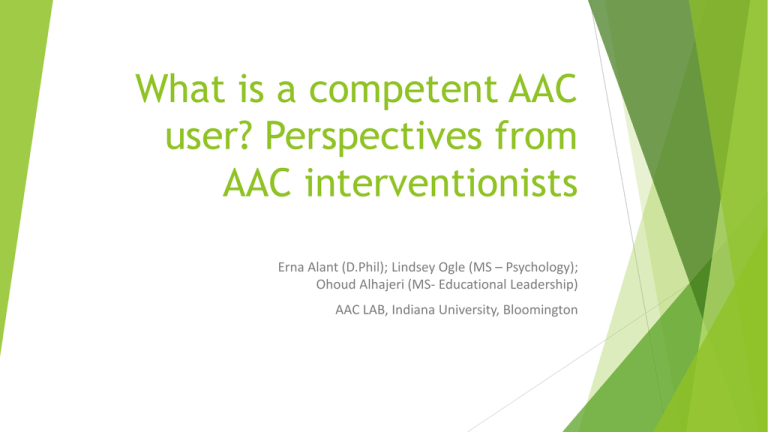
What is a competent AAC
user? Perspectives from
AAC interventionists
Erna Alant (D.Phil); Lindsey Ogle (MS – Psychology);
Ohoud Alhajeri (MS- Educational Leadership)
AAC LAB, Indiana University, Bloomington
Acknowledgements
Members of the AAC lab at Indiana University who assisted in
recruiting participants for this study
Participants who unselfishly shared their perspectives
Jesse Smith – who assisted in transcriptions
Financial Support from the Otting Foundation
Disclosure: The main researcher is currently employed by IU and
the other researchers are PhD students. There are no conflict of
interests associated with this study.
Why this research?
Major strides in technology and intervention:
New technologies
Opportunities within schools – partial to full inclusion in school
curricula
Significant increase in mobile technology applications for AAC
Concern about persistent isolation and lack of friendships for young
people with severe communication problems.
Is there an association between these concerns and the perceptions of
AAC interventionists in relation to the definition of what a competent
AAC user is?
Research questions
How do AAC interventionists define a competent user of AAC?
What aspects of an AAC system do they regard as critical to
facilitate effective communication?
What do they see as the main challenges in interactions between
AAC users and their typical peers?
What are the most important facilitators of these interactions?
What do communication partners need to know? What should
be the main focus in training?
What is the role of social media in AAC intervention?*
*Not included in preliminary analysis.
Historical Perspectives
Speed, accuracy and adaptability (use in different contexts?
1990: Janice Light: Competent AAC user include the following skills:
Linguistic
Operational
Social
Strategic
1997: Lloyd – Communication model focused on:
Purposes of Communication
Multi-modal aspects of communication
Table 1.2 Characteristics of interactions
intended to meet various social purposes
(Light, 1988)
Social Purpose of interaction
Expression of wants/needs
Information transfer
Social closeness
Social Etiquette
Characteristics of Interaction
Characteristics of interaction (Light, 1988) described according to:
Goals of interaction
Rate of communication
Focus of interaction
Tolerance for breakdowns
Duration of interaction
Number of participants
Content of communication
Independence of communicator
Predictability of communication
Partners: familiar/unfamiliar
Scope of communication
Laws for Applying Technology
(Lloyd et al., 1997)
Law of Parsimony
Law of minimal learning
Law of minimal energy
Law of minimal interference
Law of Best fit
Law of Practicality and Use
Light & Mc Naughton (2014): A new
definition for a new era in AAC?
Not just 4 areas of competency is necessary
but also a variety of psychosocial factors (e.g., motivation,
attitude, confidence, resilience) as well as barriers and
supports in the environment.
In the 25 years since this definition of communicative
competence for individuals who use AAC was originally
proposed, there have been significant changes in the AAC
field.
Three fundamental Constructs:
Functionality of Communication - Environmentally and socially
oriented; i.e use in different context, different partners, peers
Adequacy of Communication - use of language and modalities
for specific purposes, but not with reference to social context,
i.e. range or scope (different vocabulary, different functions,
multimodal) to bridge gap between skills and functional
communication in context.
Sufficiency of Knowledge, Skills and Judgment - specific skills,
knowledge to use system, language structure and content
(vocab), specific strategies for operational use
Primary Changes in Communication Competence:
Not so much what needs to be achieved as how
Main Difference – inclusion of social media – operational
competence
Social – more emphasis on interpersonal and social interactions.
More emphasis on social contact
Broader range of devices – iPads, Facebook and SGDs
Fortify psychosocial supports to increase motivation, confidence,
resilience
Environmental supports – partner training, polices etc
Methodology
Participants
Individual interactions with 12 AAC interventionists
in Indiana
8 Interviews and 4 email responses
Demographic description
ID Age Sex Years AAC
Experience
US 32 F
6
1
US 32 F
8
2
US 34 F
9
3
US 63 F
30
4
(as parent)
US 58 F
22
5
US 51 F
10
6
US 50 F
9
7
US 37 F
10
8
US 31 F
7
9
US 52 F
28
10
US 29 F
6
11
US 50 M
15
12
Overall Experience Education
in the Field
6
MA ccc 2006
Indiana University
8
MA ccc 2006
Indiana University
10
MA ccc 2004
Indiana University
18
MA Special Education
1997 Indiana University
23
MA ccc 1991
Indiana University
17
MA ccc 1992
Indiana University
24
MA ccc 1990
Indiana University
12
MA ccc 2001
Indiana University
7
MA Behavioral Analysis
2007 Indiana University
28
MA ccc 1985
Ball State
6
MA ccc 2008
Ball State
23
MA ccc 1991
Purdue
Training in AAC
No coursework, AAC diagnostics lab
AAC covered as topic in course, Clinical supervision of AAC users, Vendor
training, Self-training
No coursework, On-the-job training in low-tech AAC, In-service training
in AAC
No coursework, Training by child’s SLPs and vendors, Self-training
AAC course, CE in AAC and Hearing, Vendor training, Self-training
No coursework, CE in AAC, On-the-job training, Self-training
No coursework, CE in AAC, Clinical supervision of AAC users, Self-training
No coursework, CE in AAC, On-the-job training, In-service training
No coursework, Clinical supervision of AAC users, Self-training
AAC course, CE in AAC, Self-training
No coursework, CE in AAC, Mentored by expert in AAC, Self-training
AAC course, Clinical supervision of AAC users, Presented at conferences
and workshops on AAC
Analysis of Data
Coding semantic units
Grouping codes into categories
Assigning codes to three fundamental constructs (Light, 1989; Light and
McNaughton, 2014)
Functionality of communication: Environmentally and socially oriented; i.e use in
different context, different partners, peers
Adequacy of Communication: use of language and modalities for specific
purposes, but not with reference to social context, i.e. range or scope (different
vocabulary, different functions, multimodal) to bridge gap between skills and
functional communication in context.
Sufficiency of knowledge, skills, and judgment: specific skills, knowledge to use
system, language structure and content (vocab), specific strategies for operational
use
Trustworthiness of Data – Three researchers analyzed data and consensus
(Creswell, 2007, p. 147)
Analysis of Data – Categorical Coding Example
Category
Content
Code
Express wants and needs
Express thoughts and ideas
Different functions
Multiple language functions
Repair communication breakdowns
Self-initiates, independent use, novel utterances
Sensitive to others
Listen to others/observe/ take turns
Others are able to understand what is said
Different modalities
Combine different modalities
Different contexts &
partners
Communicate in more than one context/ environment
Communicate with different communication partners
Enjoy Use of system
Enjoys their device/ good use of their system
Understand and learn language like others
Results
What is a competent AAC user?
What are the features of an effective AAC system?
What are the biggest challenges for AAC users to interact
with typically developing communication partners?
What are the main facilitators for AAC users to interact
with typically developing communication partners?
What skills do you think communication partners need to
interact with people with little or no functional speech?
What is a competent AAC user?
Total
Construct
9
7
2
2
6
2
4
3
4
2
2
2
A
A
A
A
A
F
F
A
F
F
S
S
Code
Express wants and needs
Express thoughts and ideas
Multiple language functions
Repair communication breakdowns
Self-initiates, independent use, novel utterances
Listen to others/observe/ take turns
Others are able to understand what is said
Combine different modalities
Communicate in more than one context/ environment
Communicate with different communication partners
Enjoys their device/ good use of their system
Understand and learn language like others
Construct
Total
Comments
Sufficiency of
Knowledge & Skills
4
Adequacy of
Communication
29
Functionality of
Communication
12
What are the features of an effective AAC system?
Total
4
4
3
1
3
1
2
2
2
3
5
4
6
3
3
5
1
4
3
Construct
A
A
A
S
A
A
A
F
F
A
F
F
S
S
S
S
F
S
S
Code
Rich broad vocabulary
Use of core vocabulary
Expand & grow with individual
Access to full sentences not just words
Meet needs of individual
Repair communication breakdowns
Self-initiates, independent use
Others need to be able to understand
Turn-taking: master exchanges- getting something from others
Combine different modalities/ voice/ speech
Communicate in more than one context/ activity
Well-trained partners/ Expect communication
Accessible motorically, visually, & across contexts
Easy to manipulate vocabulary
Consistency of system over time/ Motor Planning
Easy to use/ efficiency/ speed
Minimal intrusion & distraction/ Reliable
Motivated and able to use
Sufficient rate for communication
Construct
Total
Comments
Sufficiency of
Knowledge & Skills
25
Adequacy of
Communication
20
Functionality of
Communication
14
What are the biggest challenges for AAC users to interact
with typically developing communication partners?
Total
3
8
4
4
3
2
Construct
F
F
F
F
F
F
1
S
3
2
S
F
1
2
2
F
F
S
2
1
3
1
S
F
S
S
Code
Use across contexts – school, home, community, activities
Patience of partners: don’t interrupt or guess messages, ask yes/no questions
Partner attitudes: expect AAC user has something to communicate
Uncomfortableness of partners with system
Observation skills of partner: scanning, reading expressions
Trust that partners will be patient and listen and allow AAC user to initiate not
just respond
AAC users want to show they are cognitively able – want to spell out
everything
AAC users’ lack of interest in others (autism). Going beyond just responding
Recognize need for AAC in all environments, see device as not necessary
throughout day
Partners are distracted/ overly fascinated by device
Needs to be used to communicate not just to participate in activities
How to use a teachable moment without predicting what the person would
say
Balance device training & use
Accommodating parents –lower own expectations
Lack of training of SLPs, teachers and aides in schools
Successful assessment in AAC
Construct
Total
Comments
Sufficiency of
Knowledge & Skills
14
Adequacy of
Communication
0
Functionality of
Communication
31
What are the main facilitators for AAC users to interact
with typically developing communication partners?
Total
1
2
5
1
4
4
1
3
1
2
1
3
Construct Code
F
Awareness that communication is all the time/ create opportunities
F
Importance of advocacy and modeling in the community for unfamiliar
communication partners
F
Attitudes and Dispositions – Patience, observant of AAC user expressions
F
Expectation of Communication
F
Encourage typical speakers to use AAC user’s system - fosters acceptance
S
Modeling communication on device to teach unfamiliar utterances
S
Comfort of AAC user with the communication system, Persistence
F
Desire for facilitating authentic communication to build relationships
F
Observe communication between familiar communication partners (i.e.
with family at home)
A
Use of an activity or topic to ground conversation
S
Teaching Self-Instruction
F
Collaboration with colleagues and families
Construct
Total
Comments
Sufficiency of
Knowledge & Skills
6
Adequacy of
Communication
2
Functionality of
Communication
20
What skills do you think communication partners need to
interact with people with little or no functional speech?
Total
5
2
10
3
3
6
4
2
1
1
1
1
1
1
1
Construct Code
S
Natural dispositions (patience, friendliness, honesty, persistence) vs. what can be
taught
S
Age appropriate communication
F
Patience – willingness to listen, observe, give enough space to communicate
F
Honesty – willing to admit when you don’t understand
A
Strategies to repair communication breakdowns
F
Interest in what the AAC user is communicating/ maintaining attention. Interest in
device/strategy
F
Understanding of AAC user’s experience of using communication system/ device/
model use of device
A
Acceptance of all modes of communication/behavior as communication
A
Peers as therapists/teachers instead of friends and communication partners
F
Importance of authentic communication to build relationships
F
Importance of facilitating shared experiences and fun for building camaraderie
F
Desire to work with SLP/teachers/ parents
A
Partner “ownership”/ empowerment in the intervention process
A
Advocate use of AAC device
A
Communication opportunities through day
Construct
Total
Comments
Sufficiency of
Knowledge & Skills
7
Adequacy of
Communication
9
Functionality of
Communication
26
Summary Analysis
Competent AAC User
Features of AAC System
Challenges
Facilitators
Partner Skills
Total
Sufficiency of
Knowledge and Skills
Adequacy of
Communication
Functionality of
Communication
Total
4
25
14
6
7
56
29
20
0
2
9
60
12
14
31
20
26
103
45
59
45
28
42
219
Interpretation
What is a competent AAC user?
Expressing of needs and wants- ideas and thoughts
Multimodality:
“[Someone] who can get their wants and needs and thoughts expressed
and understood by the recipient of that information. Whether it’s
through body language, using pictures, using voice, and/or using a
device. Many times it’s a combination of things to get their full
thoughts across to people – to be understood.”
Relatively few commented on the AAC users ability to understand
others – to enhance interaction
Perspective-taking
Emotional resonance
Understanding of social interactions
Features of an effective AAC system
System characteristics, operational
Multi-modality, easy access to broad vocab
“Well, I think it has to be efficient - as efficient as it can be. If the user is
really struggling with figuring it out and it’s easier to use a different means or
not talk at all, then it’s not going to be effective. So, I think that’s critical. It
shouldn’t be limiting for what they want to communicate… As someone
grows with a system, you would hope that it would not put limits on what
they want to express and what they’re able to express. I would say a system
would need to be versatile so that it can move and grow with the user.”
Relatively few:
Impact of the device in facilitating social interaction – ease of infusion into
social setting
Seeing others as part of the AAC system
Challenges in interaction with typical individuals
Difficulties in using the device
By far the majority focus on difficulties with social interaction:
“I think that the biggest challenge is, well, I think that there are a couple of
them. One that it is not completely therapist driven. That it is completely like
they are using their system to participate in the activity. So, it is not
necessarily communicative in nature. It’s just more of a participatory tool. I
feel like that is a big challenge - making the leap to use it and in a more
interactive way.”
Facilitators for interaction with typical
individuals
Majority by far:
Ability to interact in the real life
Patience of partners
“I was thinking about this this morning and you know, kids are easy
when communication is easy, but when you give them lots of guidelines
and structure it doesn’t happen as easily. Some really natural
interactions I’ve seen have happened when the communication partner,
if it’s a child, is able to use the device themselves, right?”
What should Partners be trained to do?
Majority focus on social interaction:
“Well, I think the ability to listen and wait is huge. Because communicating
with AAC is by nature just not as efficient as communicating verbally. So, if
you have a communication partner who is constantly talking verbally and
constantly jumping in then it’s going to be a less interactive exchange. So,
that’s something I think that needs to be taught.”
Conclusion
Current: Focus on social skill training – how to get the individual to get
better access to his/her own system, and those in the environment to
be patient, to listen better.
Gap: AAC intervention as the development of meaning between
people – it goes beyond sending and receiving messages.
Interest in the other; common ground (Clark, 1996)
Awareness of interaction as the development of meaning (Alant, 2005)
Uniqueness of interaction – to facilitate the development of relationships
(Crossley, 1996)
Emotional resonance (beyond perspective taking) – to facilitate “real”
interaction.
Communication Environments
Transmission
Environments
exogenous feedback
Sender/Encoder with
endogenous feedback
or Receiver/Decoder
Transmission/Signal
Channels
Receiver/Decoder
or Sender/Receiver with
endogenous feedback
Communication Contexts
(taken from Lloyd et al., 1997, p. 7, Fig. 1.1)
References
Alant, E. (2005). Intervention issues. In Alant, E & Lloyd (Eds). Augmentative and Alternative
communication: Beyond poverty. London: Whurr Publishers, 9-29.
Bruner, J. (1990). Acts of Meaning. London: Harvard University Press.
Clark, H. (1996). Using language. NY: Cambridge University Press.
Creswell, J. W. (2007). Qualitative Inquiry & Research Design. London: Sage Publications.
Crossley, N. (1996). Intersubjectivity: The fabric of social becoming. London: Sage Publications.
Light, J. (1988). Interaction involving individuals using augmentative and alternative communication
systems: State of the art and future directions. AAC, 4, 66-82.
Light, J. (1989). Toward a definition of communicative competence for individuals using
augmentative and alternative communication systems. Augmentative & Alternative
Communication, 4, 137-144.
Light, J. & McNaughton, D. (2014). Communicative Competence for Individuals who require
Augmentative and Alternative Communication: A New Definition for a New Era of
Communication? AAC, 30(1): 1–18.
Lloyd, L. L.; Fuller, D. & Arvidson, H. (1997). Augmentative and Alternative Communication: A
Handbook of Principles and Practices. Boston: Allyn Bacon.






